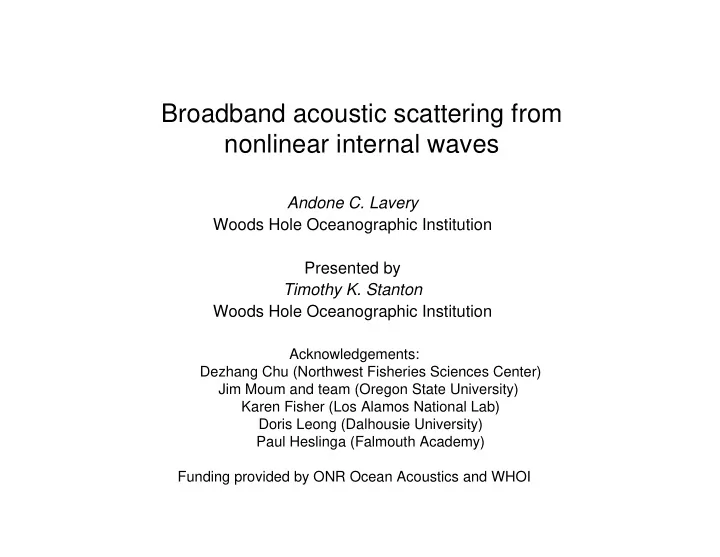

Broadband acoustic scattering from nonlinear internal waves Andone C. Lavery Woods Hole Oceanographic Institution Presented by Timothy K. Stanton Woods Hole Oceanographic Institution Acknowledgements: Dezhang Chu (Northwest Fisheries Sciences Center) Jim Moum and team (Oregon State University) Karen Fisher (Los Alamos National Lab) Doris Leong (Dalhousie University) Paul Heslinga (Falmouth Academy) Funding provided by ONR Ocean Acoustics and WHOI
Why use acoustic scattering techniques for investigating physical processes? Small zooplankton/ Microstructure? 20 Depth [m] 40 120 kHz -200 –100 0 100 200 Fish or Distance along ship track [m] large zooplankton Moum et. al ., J. Phys. Oceanography 33 , 2093-2112, 2003.
Sources of scattering and scattering models Bandwidth of Volume Scattering Strength (dB) acoustic system Fish (Gas-bearing) Siphonophores (Gas-bearing) Squid (Fluid-like?) Pteropods (Elastic-shelled) Turbulent Microstructure FREQUENCY (Hz) Medusae Euphausiids Copepods (Fluid-like) (Fluid-like) (Fluid-like)
SW06/NLIWI Experiment SARS Satellite Image Experiment duration: July 23, 2006 July 31- August 27, 2006 Long Island 50 y e s r 100 e J w e Latitude N Longitude Longitude Complex IW field
Broadband acoustic backscattering system Vertical Down-Looking Horizontal Side-Looking 4 Broadband Transducers: 160 – 270 kHz, 10 o (3dB-BW) 220 – 330 kHz , 8 o (3dB-BW) 340 – 470 kHz ,12 o (3dB-BW) 450 – 600 kHz , 9 o (3dB-BW)
measurements Microstructure (Jim Moum)
Zooplankton net tows MOCNESS: Multiple Opening/Closing Net and MOCNESS track superimposed on 120 kHz echogram Environmental Sampling System 9 8 Depth (m) 6 3 4 2 7 5 1 MOC 4: 24 August 2006 Local Time Conclusions: 1. Abundance and biomass dominated by small copepods (fluid-like) 2. Scattering dominated by small pteropods (elastic-shelled) and amphipods (fluid-like)
Mika 1: 08-14-2006 Depth (m) Broadband spectra: example 1 1 Dominated by turbulence Region 1 : Microstructure dominated. 2 Inferred dissipation: ε = 8x10 -6 W/kg. 160-270 kHz Depth (m) Volume Scattering Strength (dB) 1 Kelvin-Helmholtz shear instability (region 1) 2 220-330 kHz Depth (m) 1 Zooplankton 2 (region 2) 340-470 kHz Frequency (kHz) Depth (m) Region 2 : Zooplankton dominated. Dominated by zooplankton 1 Inferred pteropod: diameter = 0.78 mm. 2 450-600 kHz Time (GMT)
Broadband spectra: example 2 Broadband: 160-270 kHz Depth (m) region 1 region 2 Dominated by turbulence 8.05 8.1 8.15 8.2 8.25 8.3 Broadband: 450-590 kHz region 3 Depth (m) Region 2: MIXED: •Microstructure dominated at low frequencies. Dominated by zooplankton Inferred dissipation: ε = 2.5 × 10 -6 W/kg. •Zooplankton dominated at high frequencies. Time (GMT) Region 3 : Zooplankton dominated at all frequencies. Inferred: 960 pteropods/m 3 of diameter 0.53 mm.
Summary/Conclusions • First use of broadband acoustics to image microstructure. • Improved image resolution. • Improved discrimination from zooplankton. • Scattered spectra often consistent with scattering from biology alone, particularly at depths below the thermocline. • Scattered spectra consistent with scattering from turbulent oceanic microstructure alone only at a few locations, particularly in the vicinity of shear instabilities.
Recommend
More recommend